Halifax bomber LV907 ‘Friday 13th’ at Yorkshire Air Museum
‹ Return to Aviation History

Photos of crew positions in Halifax LV907
Note I have uploaded full sized images which are better for detail but may take a while to load.
Cutaway diagram showing crew positions of a Halifax bomber. Numbers relate to images detailed here.

1. Bomb Aimer and Front Air Gunner positions and Bomb Aimer’s control panel.

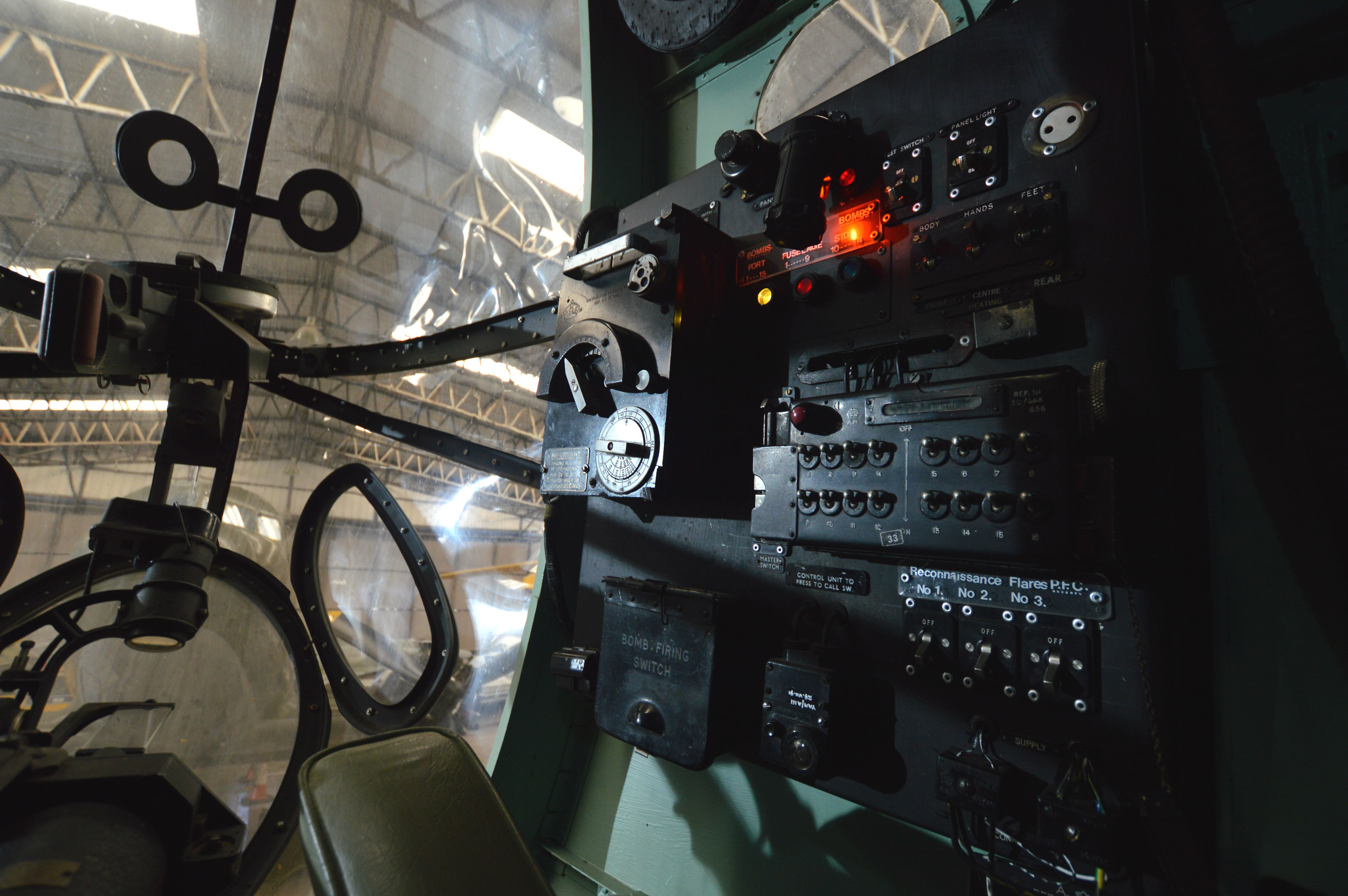
2. Navigator’s table and instruments looking towards Bomb Aimer / Front Gunner. The black bench is what the Bomb Aimer would lie on and rest his elbows on the two grey coloured pads.


3. Wireless Operator position.

4. Pilot and Navigator’s positions.


5. Flight Engineer / Second Pilot. The Flight Engineer’s position was behind the pilot and faced towards the rear of the aircraft when at the instrument panel. During take off the Flight Engineer sat in a jump seat beside the Pilot. Photo below shows the Engineer’s instrument panel and the one below that shows our guide, Grant Sparks with (inset) a period photo from wikipedia commons showing Pilot, Flight Engineer and Wireless Op positions. The third photo is the view of the starboard wing from the Flight Engineer’s position. See also 10 below – Astrodome.



6. Escape Hatch which is actually much smaller than it looks in this view through a wide angle lens and it should be borne in mind the Halifax was a lot more spacious than the Lancaster… The black object with the yellow stripes is the Mid Upper Gunner position; the crewman would sit in the turret with his feet on the stirrups. The rectangular object just to the right of that are the rear gunner’s magazines and the bullets were fed along rails from here to his position. Close to this spot (behind my position) on the port side and just the other side of the Flight Engineer’s bulkhead, was a small basket used for carrier pigeons in the event the bomber ditched at sea.

7. Mid Upper Gunner. Without climbing into the turret properly (which I probably wasn’t supposed to do but it was such a tight jam it would have been extremely difficult with a camera and flash gun anyway) this was about as good a photo as I could get. If you look closely you will just make out the two lowered guns.


8. Rear Gunner’s position. It is not possible for visitors to access the turret from inside so Grant turned it round from outside. The crewman sat on the curved plinth. There was clearly no room for a crewman to sit here and wear or have his parachute to hand.
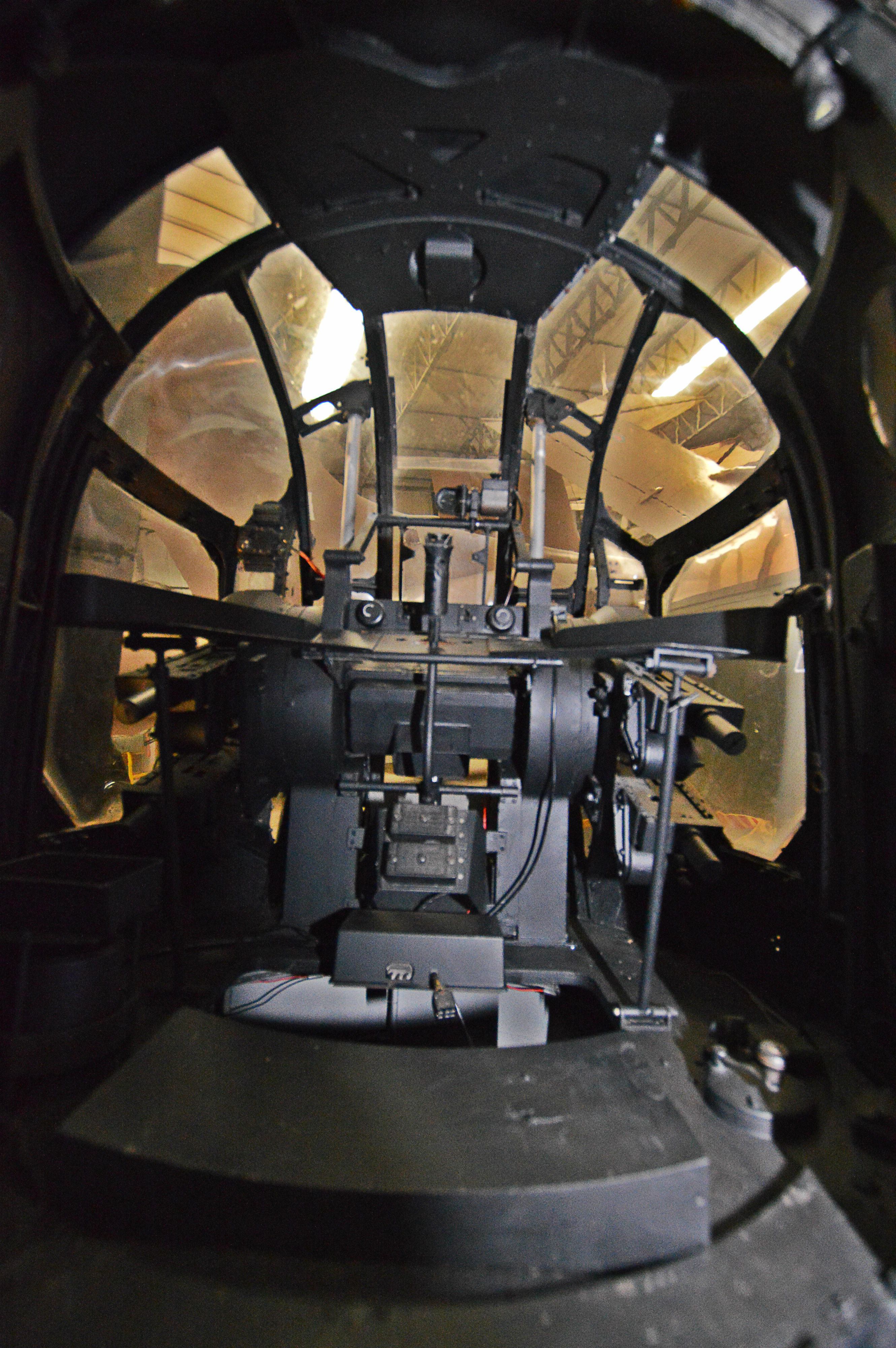

9. Entry Hatch which is at the bottom of the roundel. Once inside, and just to the left, are the magazines feeding the rear guns.

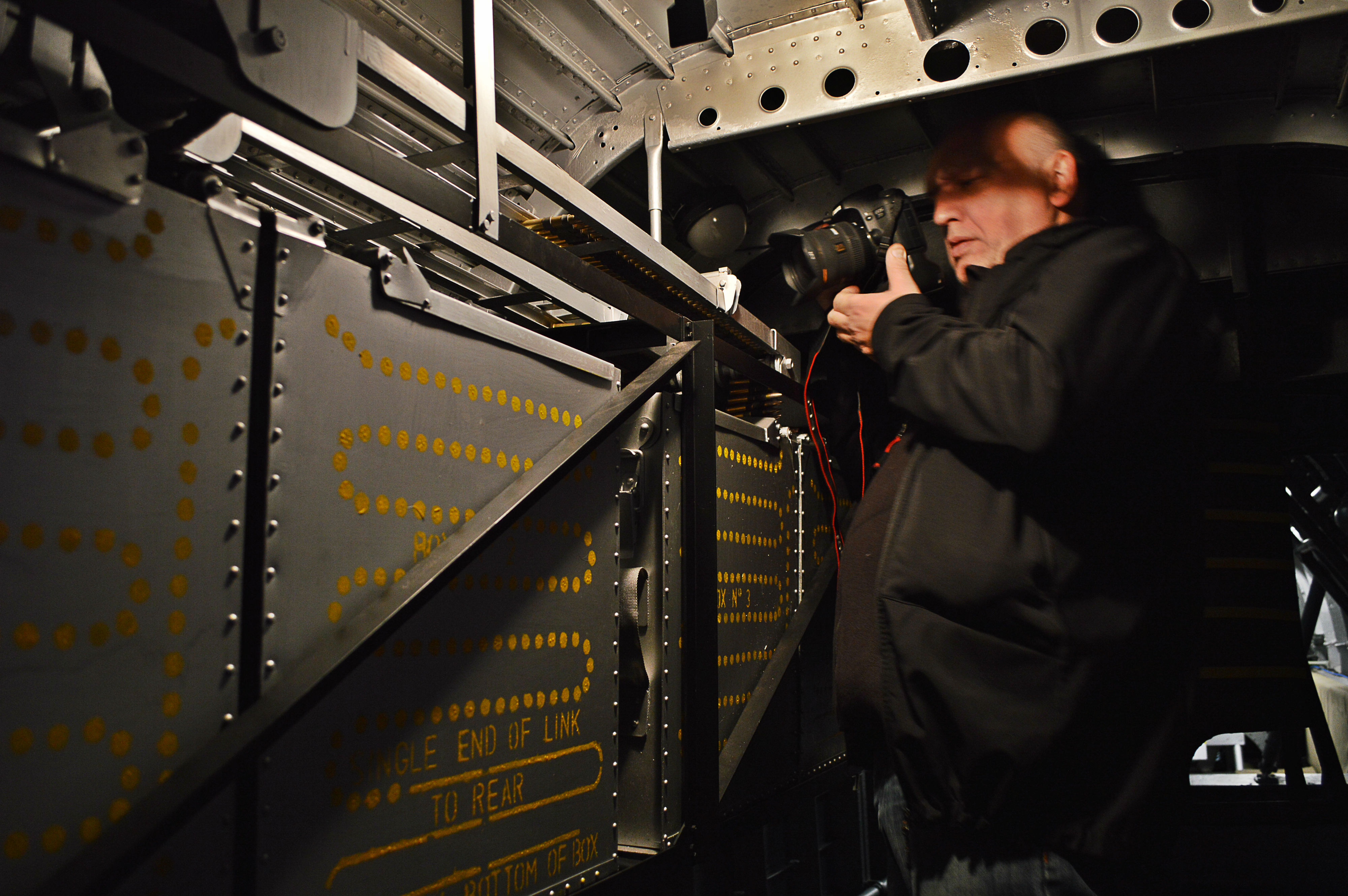
10. Astrodome for Navigator to use with a sextant during night operations to supplement other means of Navigation. Also visible is the flare gun. This is at the Flight Engineer’s position. Al is beside the pilot’s position.

Below; Crew Positions on a Halifax Bomber from an RAF recruitment poster.
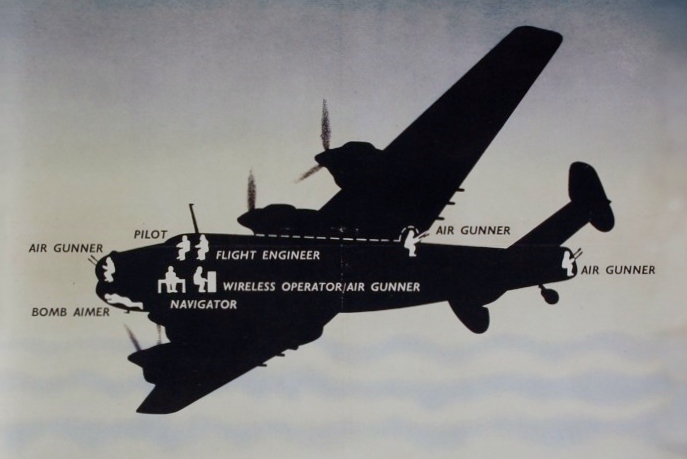
64 comments on “Halifax bomber LV907 ‘Friday 13th’ at Yorkshire Air Museum”
Leave a Reply to Mark Cancel reply
Image Information
-
Full Size: 4016×2675px
Aperture: f/4.5
Focal Length: 18mm
ISO: 400
Shutter: 1/10 sec
Camera: NIKON D3200

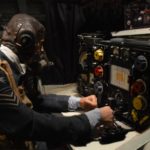
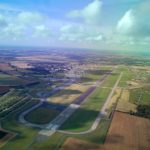
Lovely stuff Ian, this sequence gives a great feel for the layout and space inside. I’m still very surprised by the amount of space in there after seeing Lanc interiors, and wondering why Harris didn’t request a larger bomb bay to be fitted.
A grand day out for sure and an excellent record of it!
Thanks mate, yeah a grand day out.
Curious to know why the WAG is facing forward in the first cutaway but is facing backward in the last one. Which is correct?
Hi Nick, the image at the bottom is a stylised view of a bomber which to me looks like a Halifax but the poster did not identify it. This image also shows 8 (rather than 7) crew for the bomber. The first cutaway is correct as you can see in the photo of me sat at the table.
Ian
Thanks Ian.
There can only be one
this is actually my granddads plane. he flew as the rear gunner. his initials are n.p.
Hi Aidan, thanks for your comment.
Which was the Halifax your grandfather flew on? This is a reconstruction of HALIFAX LV907 ‘Friday the 13th’ which flew an incredible 128 operations. Tail gunner was a lonely position!
The starboard side of the aircraft bears the markings of Halifax NP763.
The fuselage is mostly from Halifax HR792 which crash landed on the Isle of Lewis in 1945 and for decades was a chicken coop on the island before being used to create this museum piece. The cockpit and undercarriage have been recreated though I believe the instruments are genuine.
The prop hubs are from LW687 which was shot down during the infamous Nuremberg raid of March 30th 1944 in which nearly 12% of the RAF attacking force was lost.
The wings are from freight and troop carrier Handley Page Hastings TG536.
Apparently other parts are from Halifax JP158 and I think the tail section is new and built for the project, possibly with some bits from Halifax LL505 which crashed in the Lake District. I understand the Bristol Hercules engines are from France.
Ian
On May 8 I had the distinct privilege to tour Friday The 13th both Ian and Grant were very helpful and courteous as my uncle Norm Tilston D.F.C. flew the original “13th” on Oct. 9,1944 and Jan. 14,1945. Sadly he was killed while working on his car in 1954 in Hamilton Ontario ,Canada when I was 11 years old .I was able to come to the UK this year which became a very emotional and time of closure for me for a man I loved very much. I wish to thank Grant for understanding the emotional impact the tour had on me. This photo tour inside ” 13 ” as seen on my computer has enhanced my visit. I don’t know if or when I will be in the UK but I will never forget this trip. Thanks for this opportunity!
Hi Norm, glad to have been able to provide a souvenir of sorts for you. I never met Ian but Grant was a sterling guide, very patient with us taking endless photos. A very different experience for you because of your Uncle (after whom you were named, I presume?). I can sort of imagine how you felt – I visited HMS Belfast and couldn’t help but think of my late father who served in the Royal Navy 1938 – 1945 and just wished he had been with me to show me around himself.
Ian
Ian : your assumption of where I got my name is correct. As a matter of interest to you may be the fact that I left a colour photo copy which I had laminated of Uncle Norm’s base pass with Grant . I hope he will place it with or near the plaque which has the names of the pilots of “13” .If this should happen people will be able to connect a name with a face. Uncle Norm flew the 74th and 98th flights of Friday The 13th.Your tour photos certainly are a great souvenir for me and definetly compliment those which I took.Norm L.
These are, without shadow of a doubt, the best photographs of a Halifax that I’ve seen on the web. I’m trawling through the web looking for good photos to help with the current model I’m working on but I need to look no further! Congratulations on a very informative site, I’ve now saved it my favourites folder.
Many thanks for your comment Phil, I wondered if they might be useful to modellers. As it happens, I often find myself on modeller’s websites trying to identify bits of wreckage I find at crash sites!
You should be able to download the Halifax images in their full size but let me know if you can’t and I will email them to you.
Ian
I can only download the top image in it’s full size; to be able to see the others in their full size would be fantastic!
Ok, I can see your email address, will get them to you.
Ian
Thanks Ian, I appreciate that.
I have had a look through this site and those of your wreck hunting colleagues, Military Aircraft Crash Sites, Peak Wreck Hunters and Wreck Site UK but you don’t seem to come down here to the West Country much. Are there any crash sites around here worth looking for?
You will find that many modellers are avid historians too and our spheres of interest overlap greatly. If you like I would happily put an advert for aircrashsites.co.uk on my site, Scale World (www.scaleworld.info)?
Yeah will do the same and add a link on the about page. Cheers Phil.
I don’t get down south west very often though oddly in the past week I’ve had info requests from people in Somerset and Devon. There are a few crash sites on Dartmoor with wreckage remaining. I have only visited one that way, an Albemarle bomber which crashed in Wiltshire. No debris remaining though there is a memorial to the crew.
Honeystreet crash site
Thank you for the advert, yours is also live on site.
I do love Dartmoor, though I don’t go as often as I should. If I find the sites I’ll send you the photographs.
Cheers Phil. Hope to see some crash site photos one day then!
Ian
Interesting to read about Norman (Snowy) TIlson and Friday 13th Halifax,I was Flight Engineer to Snowy throuout our tour,I am in my 91st year but still remember the letter informing me of of Snowiy’s tragic death after all we went through..
Hi Michael.
A sad memory indeed. Thank you very much for your visit and for commenting. It’s good to remember and have details like this recorded somewhere on the internet.
best wishes,
Ian
Hello. Just surfing the net regarding Friday 13th -my dad,Alfred B Robson was a wireless operator on Friday, in the last few missions under the Flight Captain Harold
Wheeler, I think round March 1945. It’s fascinating to see the photograph of the position in the plane that he would have occupied. I have a few photographs of Friday and Dad, who passed away in 2009, attended the squadron reunions. She holds a very special place in our heart and Friday 13th never holds any superstitions for us, we call it
Dads day. Thank you for the superb photos.
My pleasure, thank you for your visit and comment Gillian. You could add a photo of your Dad with the Halifax here if you wished.
Ian
My grandfather Ernie Pyle was an Armourer who was a member of the ground crew for Friday 23th.
Wow just researching the Halifax and am amazed with the info. My father was a navigator during WW2 and his brother was killed in a crash early in the war. Unfortunately my father has passed away and spoke little during our time about his activities. I do know he serves in Africa and they had the role to fly over Germany dropping silver foil to try and find the radar system thought to play a part in the V1 and V2 bombers but apart from that I know little about his war history.
Hi David,
The silver foil decoy was called Window for some reason.
Do you know anything about the air crash which killed your uncle? Date or location perhaps?
Ian
I was a Flight Engineer with 158 Sqdn at my time Friday 13th was a spare kite.I did two operations in her Oct 9th 1944to Bochum and was diverted to Horsham St Faith a USAF Liberator squadron,January 14th 1945 to Saarbrucken.our aircraft was LV 917.both were displayed on a bomb site in Oxford Steet London then sent to the scrap yard in Scotland I visited Ellington some 20years ago during a 158 re-union the video now shows the remarkable job that has been done and in particular the Flight Engineer’s position.
Hi Michael, thank you for visiting and telling us about your time with 158 Squadron, lovely to hear from you.
Ian
Hello Michael,
I wonder this being 3 years on since you last wrote if indeed you may ever see this, however I was wondering what you may remember of Duncan White McAdam, during your time with 158 Squadron?
Regards
Hi,
I’ve just seen your spectacular website showing LV907 “Friday 13th”. My Dad was bomb aimer in Halifaxes. I was looking for details of the camera used. He used to stress how important his other job was which was taking stereo pairs (two shots of the target a few seconds apart) one pair on approach and the second pair on the reciproocal path after the bombs had done their worst and looking after the camera to and from the photography lab. Without this photographic record the crew could have no idea how successful the sorties had been. Do you still have a camera? I still have some of Dad’s stereo photos taken during training exercises over Hamilton Ontario.
I must get myself up to York and visit Friday 13th someday.
http://www.462squadron.com/pages/other_personnel/horridge.html
Hi Jon, thank you for your comment. If you want to email across (address on contact page) some photos from your Dad’s training exercises in Canada, I could add them here. I am not sure of the details about the cameras bomber crews used. But yes, everything about the operation depended on men like your Dad getting it right. Great page by the way, thanks for the link.
Ian.
Thank you so much for this website. My father was an RCAF Halifax navigator for the entire war, flew more than 40 missions over France and Germany. He was 420 Squadron, or Snowy Owl Squadron in Group 6, the plane was called the Daisy Mae. There are photos online that break my heart now. But he and all the crew survived the war. He could have gone home but renewed. He used to tell me the scariest time for him was the take off, because they had the very heavily loaded planes take off into the turbulence of the plane in front. He used to spin his compass to pass the time and calm his nerves on the long night journeys, and that was one well spun compass. He eventually died of a rare blood/bone cancer, myelofibrosis, that the specialist said could have been caused by radiation exposure during the war, as it was statistically too high among long time WW II airmen. So perhaps the war got him in the end. He also said he was grateful to be in a Halifax and not a Lancaster. They did land once in England with much of one wing gone, and he said the Lanc wouldn’t have made it back.
Thank you so much for allowing me to see a bit of his experience so clearly. If you have emails of the photos I would love if you could send them so I could make some high quality prints.
Thank you Clare for sharing your Dad’s experiences with us. They were a unique generation. Every young man signing up to join a bomber crew knew the odds of him surviving were stacked against him but still joined anyway.
As for these photos, I have uploaded full sized images so you should be able to right click, view images and save to your computer or phone? Please let me know if you can’t, am happy to email them but you should be able to download them.
Hello, Phil Churchill, are you related to the Churchill who FTR from Nuremberg 1944 flying with 51 Squadron of snaith? I had three friends who flew with 51.
Hi. I have a wartime photo of my Dad, W/Co Jock Calder who miraculously survived 69 missions as a bomber pilot in 78,76 158 and 617 squadrons during WW2. I have a photo of him with 4 air crew at the tailgun turret of what I believe is a Halifax mk3 LW723 – latterly shot down in April 1944.
I have no idea who the 4 air crew are in the photo. Any assistance would be appreciated. Photo can be uploaded if it helps.
Hi Mike, if you email the photo to me I will be able to add it here.
Hi Ian,
My Grandad Philip Heslop Milne was in 518 Sqn a WO Wirless Gunner on the Halifax LL296 which crashed at Tiree after coming into contact with Halifax LL186 on August 16 1944. I only found out this last year and its an amazing story the secret missions they flew and how they stopped D-Day by one day due to the weather information they sent back that was sent to Genaral eisenhower theres much more to type and its a very sad story it me me and my farther very proud i just wish we both had met him.
Hi Philip, thank you for stopping by and commenting.
I just looked up the crash of Halifax LL296 and Halifax LL186 of 518 Meterological Squadron. I read that they also reported on U-boat activity in the Atlantic? My dad was in the Royal Navy, Atlantic and Mediterranean fleet, hunting U-boats in the later years of the war so the info your granddad reported as a wireless op would have been relayed to the destroyer he served on.
Amazing detail that his crew’s report was what postponed the invasion! You are right to be proud, they were something else, that generation. Take it you were named after Warrant Officer Philip Heslop Milne?
page about the crash with a photo of LL296
Hi, what hendel do u have to pull to drop the bombs?
This is all interesting stuff. Dad was a baby flight engineer (18yrs old) with a Canadian crew 78 squadron. 1944 shot down twice but no losses all through war. Got his log book.halifax bomber “Haynes manual” badges Inc winged fish for getting ditched. Burnt silk map and good silk map. Bit of a loss what to do with them as he was just a normal guy. Only my hero!!! Know all the crews names and all sorties. Would love to see Halifax close up. He was ditched off the OK at where I now live in Hornsea.am I being boring?
am I being boring?
Not at all!
Hi Ian, I am researching my uncle Flt Sgt S.B.Adams, who was a Halifax bomb aimer with 10sqn. I found your website while looking for information regarding the actual bomb aimers position in the aircraft which was typically crewed by seven. It is apparent that the bomb aimer also doubled as the front gunner which suggests that the aircraft would have no forward ‘fire power’ during the bombing run. I am interested to know if this is correct, or did another crew member somehow assist in the confined space. Thanks, Adam
I don’t know the answer to that Adam but I imagine the forward guns would not have been needed during the bombing run because at that point the AA fire and searchlights would have been all over the attacking bomber.
An enemy fighter defending the target would risk being shot down himself by friendly fire, so would keep clear at that point?
As I say, don’t know for sure, maybe someone else does?
My understanding is that front gunner / bomb aimer were either one and the same or was a WOPAG – there was no gunner in the front position during a bombing run. 617’s Dambuster op (Lancasters) had stirrups fitted to the powered front turret so the gunner’s feet wouldn’t interfere with the bomb aimer – clearly a front gunner was not normally present on a Lanc’s bombing run. I don’t think you could get a gunner and a bomb aimer into position at the same time in a Halifax.
Yes, fighters did tend to stand off over target but not always, especially as the Reich crumbled and desperation tactics were employed. Even then, a front gunner only really defended against head on attacks – strictly daylight tactics. My uncle (operational 1944 – May ’45) arrived over target ahead of the markers one time (winds were all to cock and he got a running fix off search lights to his north). They did a big loop to rejoin the stream (the target lit up about two minutes after they got there) and they went from first over target to last(ish) over target. At debrief, a lot of crews were relating the intense fighter activity over the target itself. My uncle and crew saw nothing.
Hi Adam, Great sight and fantastic photos. I have to go there myself soon. My father was a despatcher/air gunner with 148 “Special Duties” Sqn. based in Libya and then Brindisi, Italy flying ops over the Balkans and northern Italy mostly in Late ’43 until June ’44. He was in many different planes but all of them had no mid upper turret being “Special Duties”. The plane he flew in most was JN925 FS – X.
He only ever dropped bombs twice and that was in 17/12/44 in JN761 over Duisberg and 24/03/45 over Rhine Crossing in a Sterling.
I am hoping to correspond with any other descendants of air crew/ground crew from 148 Sqn.
Thanks again for a great site for a great plane.
A very late response, but – my late uncle Don also flew JN925 from Brindisi with 148 Sqdn; he joined the squadron from 624 (SD) Sqdn after your father had moved on. In case you haven’t come across it, there’s a FB group “Operation Dark Of The Moon” dedicated to the squadron in its Special Duties role – strongly recommend it. A number of other relatives of air and ground crew are members.
My father was Rear Gunner on Norm Tilson’s crew. We recently vivted the Halifax on display at Trenton. My father was “The Kid” Donald Robbins from Midland
My brother F/sgt James Brown was the bomb Aimer
On the Wizard of Aus which was shot down in flames when it was hit by flak going over Gladbach on 24th March, 1945. My brother and three other crew members were killed and three survived. I managed to contact Walter White who was the rear gunner and he told me that there was an almighty explosion towards the front of the plane and all communications were lost. when he released his parachute he was trapped by his boots but he was dragged out of his boots when his chute opened up.He landed in farmland and was arrested shortly after. My brother was reported missing and he is now buried in the Reichswald Forest Cemetery alongside P/O Ernest Y Yeoman and Sgt John R Williams. W/O Australian William H Hulme was also killed . They were in 158 squadron.
What beautiful photos! I myself have also been lucky enough to see the Halifax last September and take some pictures. However, my photos are not as beautiful as yours. Could I get your permission to use these pictures for my little book I am making about the crash of the LW653 of the 158 squadron in my hometown Dongen (Vaart) on May 25, 1944?
Kind regards,
Mark
Hi Mark, thank you for your kind words.
Using the photos in your book will be fine, please provide credit to aircrashsites.co.uk
It may be better not to include those photos which show people’s faces however; such use may need their explicit consent… I think? In UK law at least, if the book was to make money. You would need to check but otherwise, I own these photos and personally have no problem with you using them.
Any questions, please email me (address on contact page of this website).
Ian
Hello Ian.
Thank you for letting me use some of the photos. I will credit them to you and your website. No faces are shown on the used pictures.
kindest regards,
Mark
Hi, I just found out today that my uncle-Duncan McAdam-flew on this plane, and that’s literally all the info I have. I noticed a chap called Gregor commented asking about him, I think we may be related…..?
My father, Duncan W. McAdam was pilot of ‘Friday’, he cut the seat for his poker dice pouch, I still have it.
How can you upload photographs on this site ?
Hi Duncan, what is it you want to add? I own this website, the photos are mostly mine but I can add other photos. To do this, you would need to email them to me (contact page has email address) and I would add them.
Ian
Hi Duncan,
Thank you for sending the images of the letter and the information regarding the DFC.
Here are the images you sent.
Ian
Hi Ian
Great photos ! I am an author about to publish a book about my father’s crew (Halifax JB869 DY-H 102 Squadron…my father was the Nav). I would like to include your photo of the Nav’s position (no faces just the a/c interior) in my book, may I have you permission to do so if I credit you accordingly please Ian ?
Hi Martin, happy to help, please use whatever photos you wish as you see fit. A credit to aircrashsites.co.uk would be appreciated.
Am interested to see the book when it’s published, provide a link here if you wish?
Best wishes,
Ian
Hi there Ian – ah you’re a gent thank you and yes I will certainly credit you ! I submit my MS to Pen & Sword on 5th May and will provide a link to the book once its up on their site. Thanks again, superb images !
Best
Martin
Best of luck with it Martin.
Hi All
Just stumbled across this and was amazed at the photos. Am currently researching my family and was intrigued to discover my Grandfather Edward Williams was in 614 Sqaudron and was an astro navigator on the Halifax bombers as well as other aircraft, according to my father he was very good at it too. I am fascinated to find out more of his career and what he actually did but am struggling to find any information. I wonder if any of you kind people could point me in the right direction. I am planning a visit to this aircraft soon, recently having visited the Midlands Air museum and being given a tour of the vulcan bomber and sitting in the navigators seat its really caught my interest and would love to sit in the Halifax to get a feel of what my grandad would have experienced. Any help would be fantastic, these photos and the information has totally blown me away, thankyou for such a wonderful, informative page.
Many thanks, Rob
Hi Rob,
I am glad you like the photos and the information, thank you for the feedback.
Key to determining your gradfather’s war record will be getting hold of his service record. If you don’t have access to that, you can apply to the MoD here. There is a fee of £30, I think and you need to show you are the nearest relative.
Not sure what you have tried already, but RAF Squadron records used to be available from the National Archives, I don’t think they are now? A quick google round brought up some of those Ancestry websites. The RAF Museum may be your best first contact, I am sure someone there will be able to advise, and there is an email contact.
You might also try the 614 Sqn Facebook group.
One final mention is the RAF Commands Forum. The people on there are very knowledgable and may be able to help with any specific requests.
Hope this gives you some pointers, good luck with your research and let us know how you get on?
Ian
My father was in the 76th Squadron. They were shot down in November 1943. The pilot was killed, the rest of the crew became prisoners of war,until the Russians freed them.
I would love to see a Halifax up close but l don’t think their are any in this country.
Thank you for sharing these pictures, they are amazing.Do you have any copies for sale please.
Hi Janet,
Thank you for your comment.
Are you in Canada?
These images are saved here at high resolution. They are not for sale but you can download them and use them; if you were putting copies of them online, a credit to aircrashsites.co.uk would be appreciated!
Ian